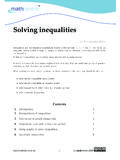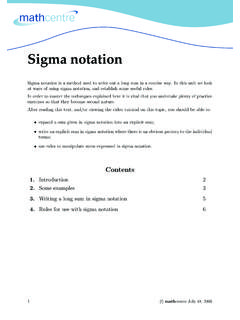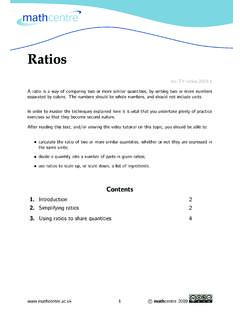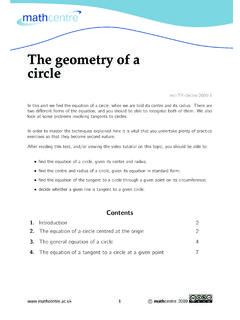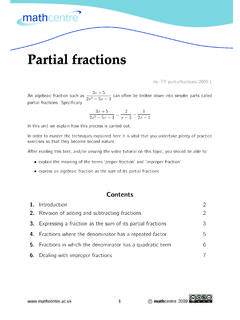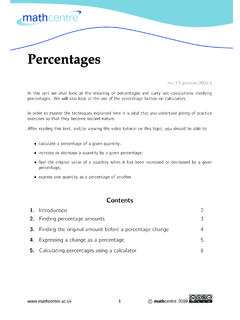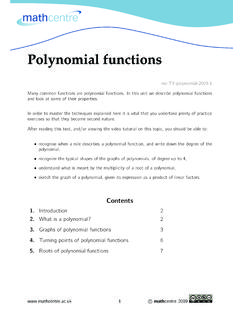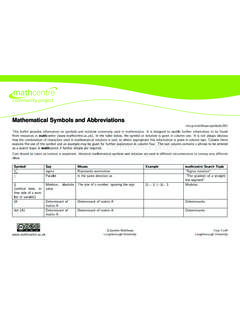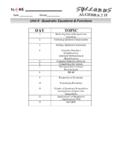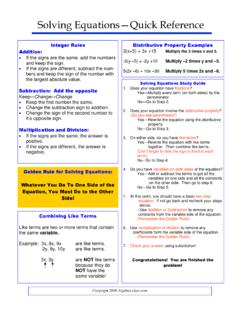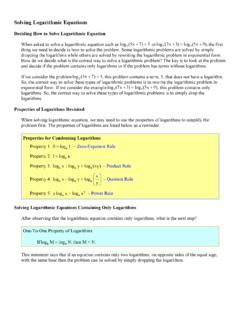Transcription of Quadratic Equations - Mathematics resources
1 Quadratic Equationsmc-TY-quadeqns-1 This unit is about the solution of Quadratic Equations . These take the formax2+bx+c= 0. Wewill look at four methods: solution by factorisation, solution by completing the square, solutionusing a formula, and solution using graphsIn order to master the techniques explained here it is vital that you undertake plenty of practiceexercises so that they become second reading this text, and/or viewing the video tutorial on this topic, you should be able to: solve Quadratic Equations by factorisation solve Quadratic Equations by completing the square solve Quadratic Equations using a formula solve Quadratic Equations by drawing Quadratic Equations by Quadratic Equations by completing the Quadratic Equations using a Quadratic Equations by using mathcentre 20091.
2 IntroductionThis unit is about how to solve Quadratic Equations . Aquadratic equationis one which mustcontain a term involvingx2, , 5x2or justx2on its own. It may also contain termsinvolvingx, 7x, It can also have constant terms - these are just numbers:6, 7, cannot have terms involving higher powers ofx, likex3. It cannot have terms like1xin general a Quadratic equation will take the formax2+bx+c= 0acan be any number excluding be any numbers including zero. Ifborcis zerothen these terms will not PointA Quadratic equation takes the formax2+bx+c= 0wherea,bandcare numbers. The numberacannot be this unit we will look at how to solve Quadratic Equations using four methods: solution by factorisation solution by completing the square solution using a formula solution using graphsFactorisation and use of the formula are particularly Solving Quadratic Equations by factorisationIn this section we will assume that you already know how to factorise a Quadratic expression.
3 Ifthis is not the case you can study other material in this series where factorisation is we wish to solve3x2= begin by writing this in the standard form of a Quadratic equation by subtracting 27 fromeach side to give3x2 27 = mathcentre 2009We now look for common factors. By observation there is a common factor of 3 in both factor is extracted and written outside a pair of brackets. The contents of the brackets areadjusted accordingly:3x2 27 = 3(x2 9) = 0 Notice here the difference of two squares which can be factorised as3(x2 9) = 3(x 3)(x+ 3) = 0If two quantities are multiplied together and the result is zero then either or both of the quantitiesmust be zero. So eitherx 3 = 0orx+ 3 = 0so thatx= 3orx= 3 These are the two solutions of the we wish to solve5x2+ 3x= look to see if we can spot any common factors.
4 There is a common factor ofxin bothterms. This is extracted and written in front of a pair of brackets:x(5x+ 3) = 0 Then eitherx= 0or5x+ 3 = 0from whichx= 35. These are the two this example there is no constant term. A common error thatstudents make is to cancel thecommon factor ofxin the original equation:5x 2+ 3 x= 0so that5x+ 3 = 0givingx= 35 But if we do this we lose the solutionx= 0. In general, when solving Quadratic Equations weare looking for two we wish to solvex2 5x+ 6 = factorise the Quadratic by looking for two numbers which multiply together to give 6, andadd to give 5. Now 3 2 = 6 3 + 2 = 5so the two numbers are 3and 2. We use these two numbers to write 5xas 3x 2xandproceed to factorise as follows:x2 5x+ 6 = 0x2 3x 2x+ 6 = 0x(x 3) 2(x 3) = 0(x 3)(x 2) = 0from whichx 3 = 0orx 2 = 0so thatx= 3orx= 2 These are the two mathcentre 2009 ExampleSuppose we wish to solve the equation2x2+ 3x 2 = factorise this we seek two numbers which multiply to give 4(the coefficient ofx2multipliedby the constant term) and which add together to give 1 = 44 + 1 = 3so the two numbers are4and 1.
5 We use these two numbers to write3xas4x xand thenfactorise as follows:2x2+ 3x 2 = 02x2+ 4x x 2 = 02x(x+ 2) (x+ 2) = 0(x+ 2)(2x 1) = 0from whichx+ 2 = 0or2x 1 = 0so thatx= 2orx=12 These are the two we wish to solve4x2+ 9 = of all we write this in the standard form:4x2 12x+ 9 = 0We should look to see if there is a common factor - but there is not. To factorise we seek twonumbers which multiply to give 36 (the coefficient ofx2multiplied by the constant term) andadd to give 12. Now, by inspection, 6 6 = 36 6 + 6 = 12so the two numbers are 6and 6. We use these two numbers to write 12xas 6x 6xandproceed to factorise as follows:4x2 12x+ 9 = 04x2 6x 6x+ 9 = 02x(2x 3) 3(2x 3) = 0(2x 3)(2x 3) = 0from which2x 3 = 0or2x 3 = 0so thatx=32orx=32 These are the two solutions, but we have obtained the same answer twice.
6 So we can havequadratic Equations for which the solution is mathcentre 2009 ExampleSuppose we wish to solvex2 3x 2 = are looking for two numbers which multiply to give 2and add together to give 3. Nevermind how hard you try you will not find any such two numbers. So this equation will not need another approach. This is the topic of the next 1 Use factorisation to solve the following Quadratic equationsa)x2 3x+ 2 = 0b)5x2= 20c)x2 5 = 4xd)2x2= 10xe)x2+ 19x+ 60 = 0f)2x2+x 6 = 0g)2x2 x 6 = 0h)4x2= 11x 63. Solving Quadratic Equations by completing the squareExampleSuppose we wish to solvex2 3x 2 = order to complete the square we look at the first two terms, and try to write them in the form()2. Clearly we need anxin the brackets:(x+ ?
7 2because when the term in brackets is squared this will give the termx2We also need the number 32, which is half of the coefficient ofxin the Quadratic equation,(x 32)2because when the term in brackets is squared this will give the term 3xHowever, removing the brackets from(x 32)2we see there is also a term( 32)2which wedo not want, and so we subtract this again. So the Quadratic equation can be writtenx2 3x 2 =(x 32)2 ( 32)2 2 = 0 Simplifying(x 32)2 94 2 = 0(x 32)2 174= 0(x 32)2=174x 32= 172or 172x=32+ 172orx=32 172We can write these solutions asx=3 + 172or3 172 Again we have two answers. These are exact answers. Approximate values can be obtained usinga mathcentre 2009 Exercise 2a) Show thatx2+ 2x= (x+ 1)2 , use completing the square to solvex2+ 2x 3 = ) Show thatx2 6x= (x 3)2 use completing the square to solvex2 6x= ) Use completing the square to solvex2 5x+ 1 = ) Use completing the square to solvex2+ 8x+ 4 = Solving Quadratic Equations using a formulaConsider the general Quadratic equationax2+bx+c= is a formula for solving this:x= b b2 4ac2a.
8 It is so important that you should PointFormula for solvingax2+bx+c= 0:x= b b2 4ac2aWe will illustrate the use of this formula in the following we wish to solvex2 3x 2 = this with the general formax2+bx+c= 0we see thata= 1,b= 3andc= values are substituted into the b b2 4ac2a= ( 3) ( 3)2 4 1 ( 2)2 1=3 9 + 82=3 172 These solutions are mathcentre 2009 ExampleSuppose we wish to solve3x2= 5x we write this in the standard form as3x2 5x+ 1 = 0in order to identify the values ofa, see thata= 3,b= 5andc= 1. These values are substituted into the b b2 4ac2a= ( 5) ( 5)2 4 3 12 3=5 25 126=5 136 Again there are two exact solutions. Approximate values could be obtained using a 3 Use the Quadratic formula to solve the following Quadratic )x2 3x+ 2 = 0b)4x2 11x+ 6 = 0c)x2 5x 2 = 0d)3x2+ 12x+ 2 = 0e)2x2= 3x+ 1f)x2+ 3 = 2xg)x2+ 4x= 10h)25x2= 40x 165.
9 Solving Quadratic Equations by using graphsIn this section we will see how graphs can be used to solve Quadratic Equations . If the coefficientofx2in the Quadratic expressionax2+bx+cis positive then a graph ofy=ax2+bx+cwilltake the form shown in Figure 1(a). If the coefficient ofx2is negative the graph will take theform shown in Figure 1(b).(a)(b)a > 0a < 0 Figure 1. Graphs ofy=ax2+bx+chave these general shapesWe will now addxandyaxes. Figure 2 shows what can happen when we plot a graph ofy=ax2+bx+cfor the case in whichais positive.(a)(b)(c)xxxyyyFigure 2. Graphs ofy=ax2+bx+cwhenais mathcentre 2009 The horizontal line, thexaxis, corresponds to points on the graph wherey= 0. So points wherethe graph touches or crosses this axis correspond to solutions ofax2+bx+c= Figure 2, the graph in (a) never cuts or touches the horizontal axis and so this correspondsto a Quadratic equationax2+bx+c= 0having no real graph in (b) just touches the horizontal axis corresponding to the case in which the quadraticequation has two equal roots, also called repeated roots.
10 The graph in (c) cuts the horizontal axis twice, corresponding to the case in which the quadraticequation has two different we have done in Figure 2 for the the case in whichais positive we can do for the case inwhichais negative. This case is shown in Figure 3.(a)(b)(c)xxxyyyFigure 3. Graphs ofy=ax2+bx+cwhenais negativeReferring to Figure 3: in case (a) there are no real roots. In case (b) there will be repeatedroots. Case (c) corresponds to there being two real we wish to solvex2 3x 2 = considery=x2 3x 2and produce a table of values so that we can plot a 2 10 1 2 345x24 1 0 1 4 9 16 25 3x6 3 0 3 6 9 12 15 2 2 2 2 2 2 2 2 2x2 3x 28 2 2 4 4 228 From this table of values a graph can be plotted, or sketched as shown in Figure 4.
